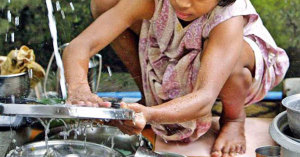Experiences of many countries including Bangladesh show that social protection measures are useful in reducing child labour.
Published in The Daily Star on Tuesday, 13 October 2015.
MACRO MIRROR
A BETTER TOMORROW
Dr Fahmida Khatun
THE issue of exploitation of child domestic labour does not catch our attention unless there is sensational news of torture in the media. At an age when they are supposed to be in school or at the playground, these children find themselves in the houses of well-off families, doing all kinds of arduous household chores from early morning to late night, cleaning and serving customers in shops and restaurants, as helping hands on farmlands, or in factories working in hazardous conditions. Many are on the streets begging along with adults, from an age when they can barely speak.
In Bangladesh, poverty has decreased significantly over the years. Yet, the absolute number of poor people is large as the population is high. Children remain the worst-hit by poverty. For poor families, they are the breadwinners and additional sources of income. Many of them are thus separated from their families and enslaved in the harshest of working conditions. However, poverty and child labour are linked in both ways. Economic vulnerabilities lead to child labour. But as these children are deprived of education and skills – many of whom also suffer irreversible physical and psychological damage – their opportunity for better livelihood options in the future remain limited. Ultimately, they fall into poverty later in their lives. And their children are born into a poor family. Thus, an inter-generational poverty cycle is created that gives rise to an unequal society. The success of Bangladesh in meeting Millennium Development Goals on universal primary education is praiseworthy. Despite higher access to schools and increased enrolment, the drop-out rate is still quite high. And these are the children of poor families who work as child labourers.
Several laws are in place that call for protecting child rights and prohibiting child labour. Starting from the Convention on the Rights of the Child in 1990 to the National Child Policy 2011 — all emphasise the need to abolish child labour. The Child Labour Unit set up in 2009 at the Ministry of Labour and Employment has the responsibility to coordinate child labour related policies and measures, and work towards elimination of child labour. But this unit needs to be strengthened with financial and human resources and be more pro-active. The Ministry of Labour and Employment adopted a National Child Labour Elimination Policy 2010. This aims to eliminate all forms of child labour by 2015. However, we still have miles to go before we reach a situation without child labour. Laws typically lack strong enforcement mechanism for the child labour provisions. Also, since more than 90 percent children are engaged in the informal sector, the enforcement of legal measures is also difficult. This is reflective of the very nature of our economy where the share of the informal sector is much higher than that of the formal sector.
Another important way to uproot child labour is allocation of adequate resources by the government. A study of the Centre for Policy Dialogue and United Nations Children’s Fund, in which this columnist was a contributor, reveals that though allocation for children’s education, health and protection has improved compared to before, in terms of share in the national budget, the amount dedicated exclusively for children is still very low. The report estimated that the total budget directly allocated for children, including allocations for children’s social safety net programmes, amounted to 4.1percent of the national budget of FY 2010-2011. This was equivalent to 0.7 percent of gross domestic product of the country. Disappointingly, though the size of the national budget has been increasing every year, the share of children’s budget has stayed almost the same in the past years. This reiterates the need for a child-friendly budget whereby resources will be allocated in a way that directly benefits children. About 45 percent of our population consists of children under 18 years. Therefore, the development of the country is intrinsically related to the welfare of this segment of the population.
Experiences of many countries including Bangladesh show that social protection measures are useful in reducing child labour.
‘Bolsa Familia’ cash transfer programme for children to go to school in Brazil or cash transfers under Education Sector Support Project scholarship programme in Cambodia are examples of initiatives which helped reduce child labour. Health insurance of family members or old age allowance has been useful in many African countries in lowering child labour as they provide a source of income and sense of social security. Bangladesh is pursuing several social safety net programmes for a long time, mainly in the form of direct cash transfer, food transfers and micro-credit aimed at supporting the vulnerable groups of the society. While these have improved the welfare of families and in turn of children, more such programmes are needed that target children specifically.
According to the International Labour Organisation, child labour is harmful to the physical and mental development of children as it deprives children of their childhood, their potential and their dignity. To explore the true potential of our deprived children and ensure their right to live with dignity, the rest of society will also have to uphold a sense of dignity within itself which will not allow its members to employ and exploit child labour, but to work towards combating such evils. This, of course, needs a total change in our societal and cultural outlook.
The writer is Research Director at the Centre for Policy Dialogue, currently a Visiting Scholar at the Centre for Study of Science, Technology & Policy, India.


